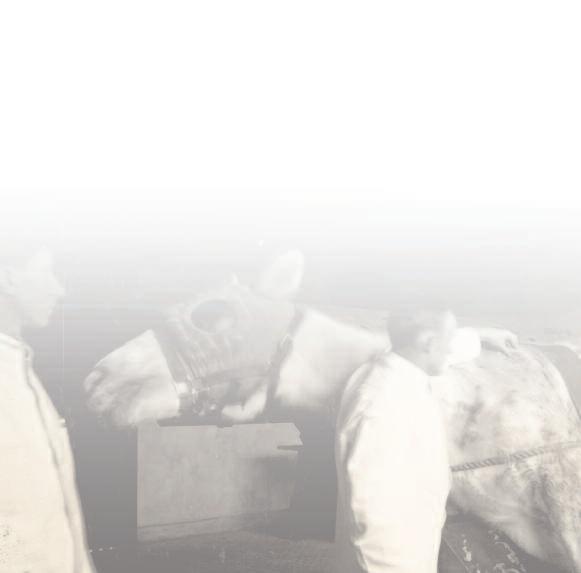
9 minute read
Advances in Equine Veter inar y Medicine
BY JANE SIMONE
Veterinary medicine’s history is fascinating And equine veterinary medicine especially so, since the horse was key to humankind’s advancement As English poet Ronald Duncan eloquently put it, “Our past has been borne on his back All our history is his industry.We are his heirs, he our inheritance ”The horse allowed transport to evolve; he carried warriors into battle, pulled produce-laden barges along canals, hauled coal from mines to heat homes and fuel industry, ploughed fields and carried mail And of course, he ran races and chased the fox and brought excitement, beauty and a very special human-animal bond into being
As cr itical as horses have been through the millennia to human beings, for centur ies equine medical care, treatment and therapy chiefly lurked in an abyss of ignorance There were occasional enlightened voices, but they were few and f ar between In the fifth centur y BC, the Greek general Xenophon admonished, “Never act with anger toward a horse,” advice as wise now as it was then.
Xenophon knew how impor tant the horse’s foot was to its welf are and that clean stabling and good pasture helped keep a horse healthy The same is tr ue today, but after centur ies of treatments and remedies that ranged from the most appalling cr uelty to r idiculous wishful thinking (with a few lucky breaks in between) today’s equine veter inar y medicine offers sophisticated diagnostics, safe, successful surg ical techniques and dr ugs and anesthesia that br ing relief and recover y
Looking back over Penn Vet’s 125-year histor y is like opening a time-capsule on equine veter inar y medicine On September 1, 1885, the Veter inar y Hospital (including a f ar r ier shop) then located on Pine Street, began receiving patients pr imar ily horses This was just 20 years after the end of the Amer ican Civil War, a conflict that threw into shar p relief the dire need for improved medical treatment of horses It is estimated that approximately 1 5 million horses (cavalr y mounts and animals that pulled supply wagons, field ambulances, ar tiller y, etc ) died dur ing the war, an appalling loss
Penn Vet’s pr imar y focus would be on horses and food-andfiber animals during its first half-century of existence, but it was only after New Bolton Center opened in 1952 that the school made significant advances in equine veter inar y medicine.
But Penn’s reputation as a place where r igorous intellectual cur iosity was encouraged resulted in a fortuitous gather ing of some of the most outstanding veter inary minds of the time The collective intellects of Penn Vet clinicians such as Dr Mark Allam, Dr. Charles Raker, Dr. Jacques Jenny, Dr. David Nunamaker and others too numerous to mention created a climate of enthusiasm to meet challenges in equine surger y and medicine shunned until then In addition, the role of the horse in ever y day life had changed dramatically Once predominantly indispensable work animals, horses became partners in a var iety of elite equestr ian sports, as well as fox-hunting and pleasure r iding. Owners were willing to support and encourage improved veter inar y care for their horses as well as research into their afflictions
For the horse, there have always been two g reat enemies of good health: foot and leg soundness and gastro-intestinal problems. Horse owners r ightly fear a diagnosis of laminitis or colic Surger y of any sor t car r ied tremendous r isk Dr Charles Raker, professor emer itus, recalled that nearly 80 per cent of colic surger y patients died in the early days of those procedures
In more than 50 years of work at New Bolton Center, that statistic has changed dramatically. Today, more than 80 per cent of horses having colic surger y that are recovered from general anesthesia sur vive a complete reversal from the early days
The creation of a Section for Emergency, Cr itical Care and Anesthesia at New Bolton Center has led to research projects that are investigating cer tain g rowth f actors (proteins) impor tant to the healing of all body tissues Dr. Louise Southwood states that these proteins may have a cr itical role in helping enhance intestinal healing in horses with severe GI injur y Her initial research results are encourag ing The ultimate objective is to use gene therapy to deliver these g rowth f actors to colic patients’ intestines to help healing Another study is looking at the sur vival and complication rates of ger iatr ic horses with colic, par ticularly those having surger y, compared with non-ger iatr ic (mature) horses and again, initial findings are ver y encourag ing
The r igid endoscope, developed by Dr Frank Kral in the early 1950s, and its 1970s replacement, the flexible endoscope, significantly improved equine upper respiratory evaluations In conjunction with New Bolton Center’s highspeed treadmill these tools revolutionized the diagnosing and treatment of the equine airway
Dr. David Nunamaker, who recently retired from New Bolton Center’s f aculty as the Jacques Jenny Professor of Or thopaedic Surger y, tirelessly pursued g reater understanding of the mechanics of bone modeling and remodeling in horses, based on var ious types of exercise surf aces, and designed a now widely used exter nal fixation device for horses suffer ing catastrophic leg fractures In the Richard S Reynolds Comparative Or thopaedic Research Laborator y, Nunamaker conducted in-depth research into many conditions affecting Thoroughbred and Standardbred race horses, such as bucked shins, f atigue fractures and bone and fracture treatments His work offered the racing industr y enlightened alter natives to traditional training methods that would benefit the horse
Ar throscopic surger y (led by Dr Dean W Richardson, chief of New Bolton Center’s Section of Surger y), laser surger y (pioneered by the late Dr. Er ic Tulleners and evolving under Dr. Er ic Parente’s leadership) and highly sophisticated imag ing modalities (dig ital radiology, MRI, nuclear scintig raphy, ultrasound) are cr itical f actors in diagnosing and treating today’s horse Cardiology as an equine specialty has reached undreamed of levels of accuracy and sophistication under the guidance and exper tise of Dr. Virg inia Reef.
In the forefront of New Bolton Center’s ser vices and work is its excellence in treating or thopaedic patients Dr. Jacques Jenny, a noted Swiss or thopedic surgeon defied convention in the 1950s and 1960s by attempting to repair fractures in horses’ legs Jenny’s pioneer ing work on equine joint surger y went well, but post-operative recover y often led to the horse panicking as it emerged from anesthesia, either re-injur ing the damaged leg or breaking a different limb Jenny’s fr ustration over these f ailures inspired him to conceptualize an anesthesia recover y method that has proved a tremendous boon to patient and surgeon alike He developed the f amous “pool recover y system,” which to this day, according to Richardson, g ives surgeons the confidence to attempt the most difficult types of or thopaedic repairs repairs that would have been unheard of 40 or 50 years ago
Horses are awoken from anesthesia in a specially designed and constr ucted r ubber raft in a large, heated pool that allows them to kick freely without r isk of injur y. Once fully awake, the patient is lifted from the raft and pool secure in a sling and allowed to stand up calmly, or is transpor ted by monorail to the Widener Hospital’s Intensive Care Unit to the safety of a well-bedded stall One of only four such recover y systems in the US, the pool at New Bolton Center remains unique in its scope and is a dramatic illustration of how f ar equine veter inar y medicine has come since the days when horses were routinely euthanized for catastrophic (and not so catastrophic) or thopaedic injur ies
These surg ical tr iumphs would have been impossible without advances in large animal general anesthesia

Anesthesia for large animal patients had been used, but it was fraught with danger. Both the drugs and equipment used contr ibuted to those dangers, but in the late 1950s and early 1960s, spur red on by educational and research opportunities offered through Penn Vet’s close proximity to Penn’s School of Medicine, the veter inar y school made g reat prog ress in both small and large animal anesthesiology
Significant pioneers of successful equine anesthesia are New Bolton Center’s Dr. Lawrence Soma and Dr. Lin Klein, whose work in this field has led to remarkable achievements
Soma highlighted the introduction of improved inhalational anesthesia as the “great leap forward” that increased positive outcomes for equine surgery Before this, local anesthesia, sedatives, ether and intravenous medications provided insufficient muscle relaxation and analgesic relief (not to mention, in the case of ether, danger to patient and clinician alike); the ability to deliver anesthesia safely and in adequate quantities through inhalation to ensure adequate muscle relaxation and pain-free procedures significantly enhanced the chances of a favorable outcome for the patient
But with these advances came the need for improved anesthesia equipment and medications for large animals Through innovation and creativity Soma and his colleagues pushed those boundar ies until today there are companies willing and able to manuf acture the equipment that complex large animal surger y techniques demand
Many individuals at Penn Vet contr ibuted to the discover ies and innovations that have changed equine surger y from barbarous procedures in days long past to the sophisticated, safe and relatively routine procedures perfor med now The histor y of the horse is stained with intentional and unintentional cruelties masquerading as treatment In today’s enlightened era we continue to str ive for even better remedies for one of mankind’s most beloved animal partners, but much will depend on the veter inar y profession’s ability to invest time, energy and resources to advance its knowledge As an example, Penn Vet’s implementation of a special initiative to investigate the causes and find a cure for the horse’s most stubbor n and elusive foe, laminitis, will require more than $15 million to adequately fund Nevertheless, true to its mission the school is pressing forward with this initiative and with the help of people ever ywhere who care about the horse and its well being we look to the future with optimism and hope




